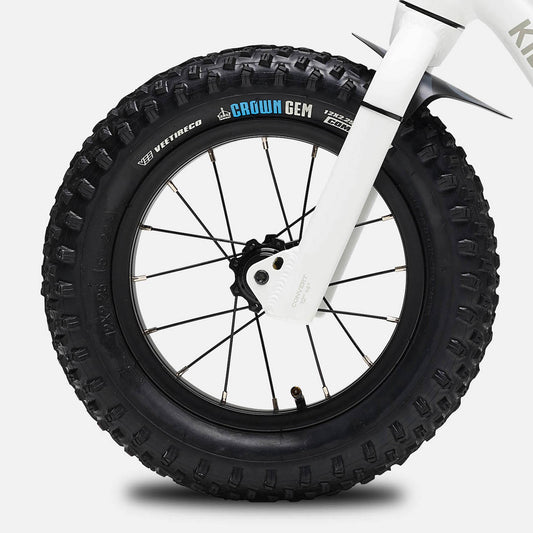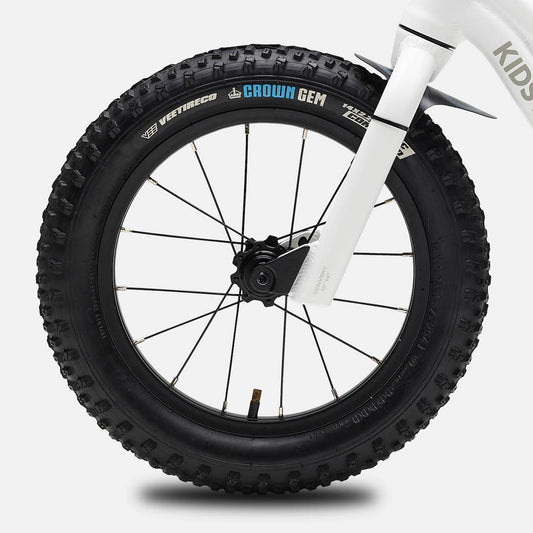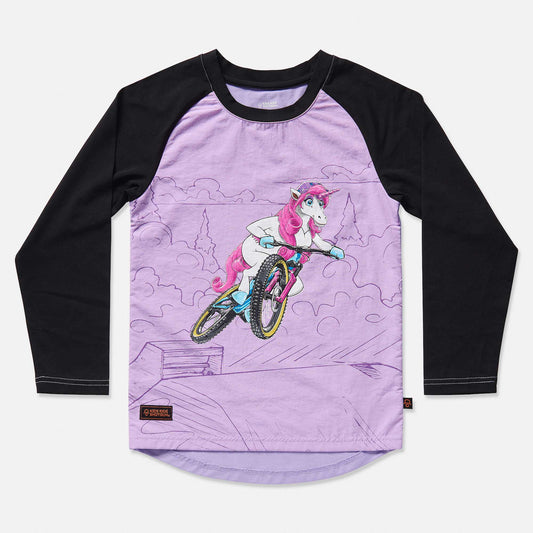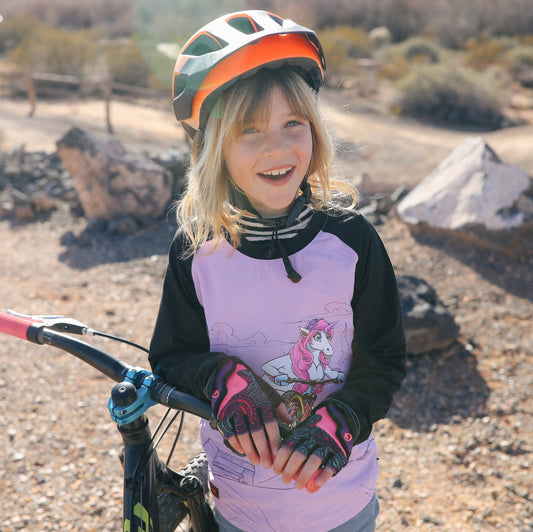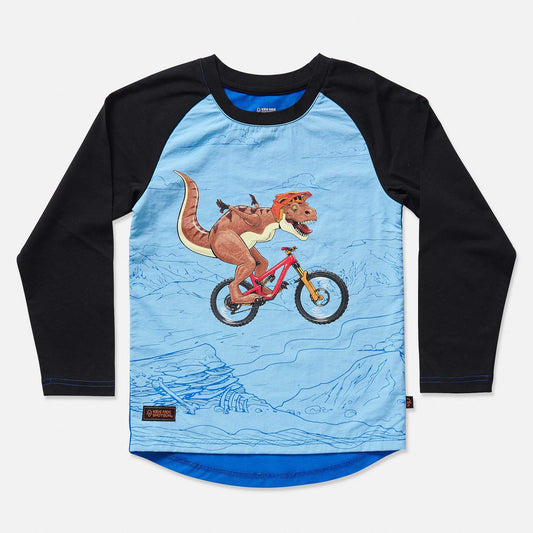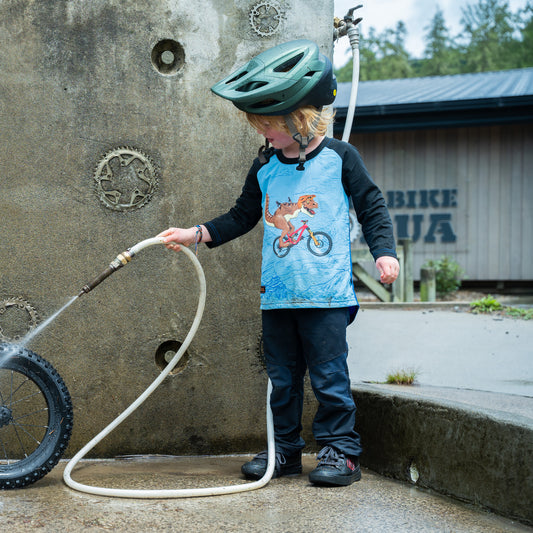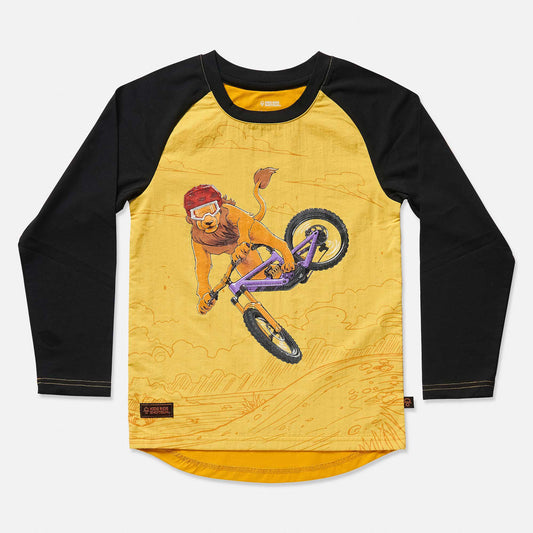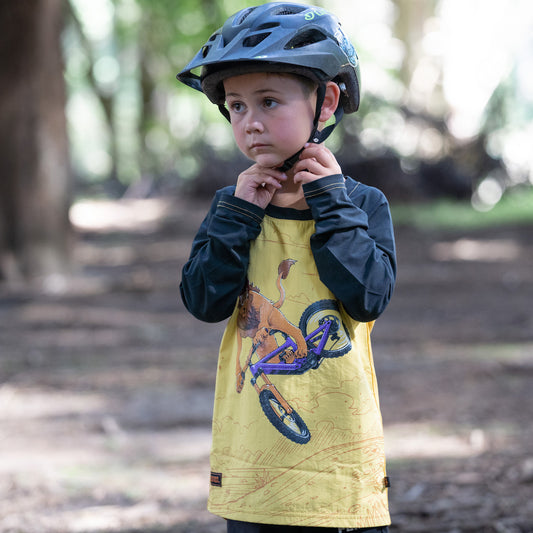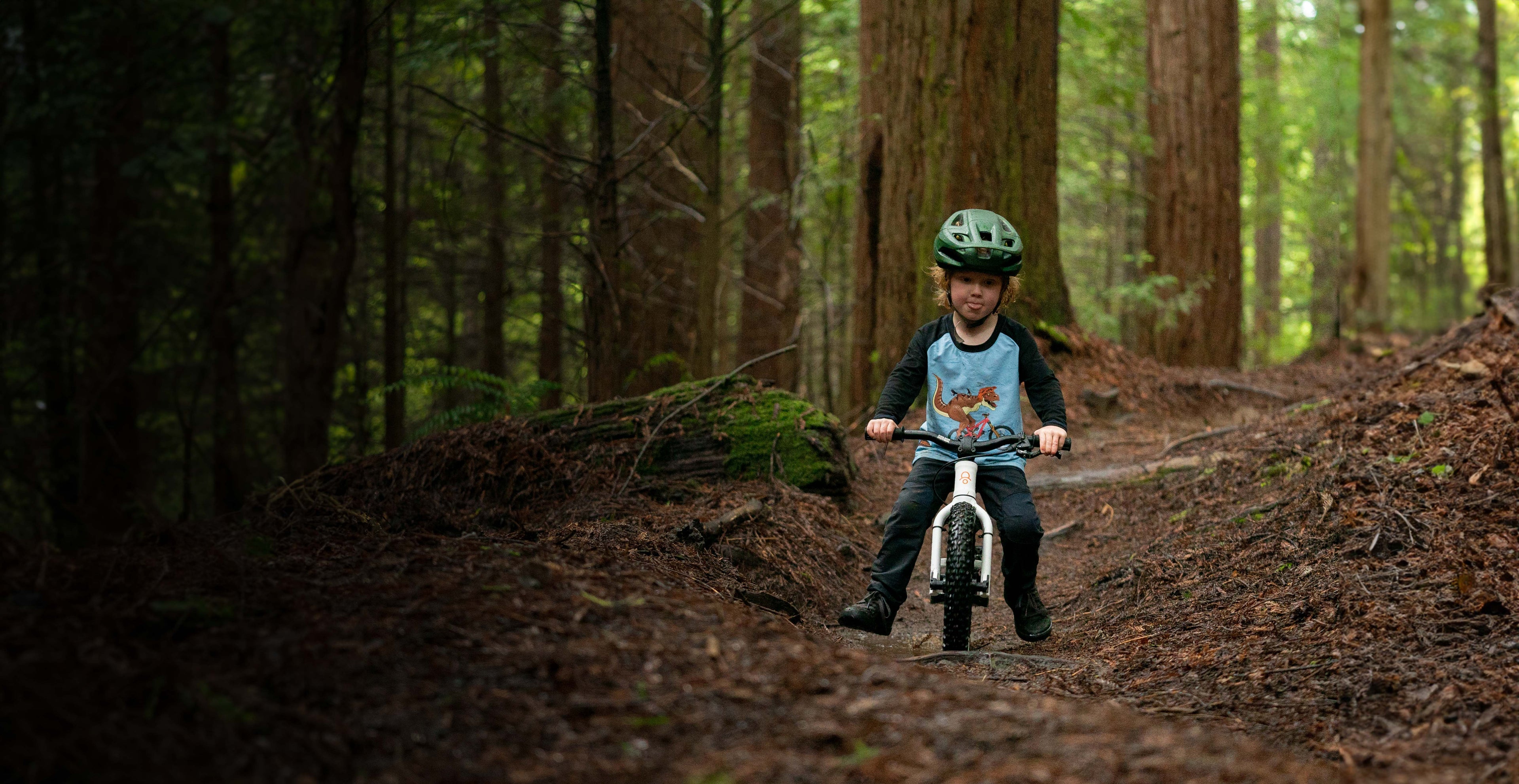
OFF-ROAD BALANCE BIKES
No pedals? No problem.
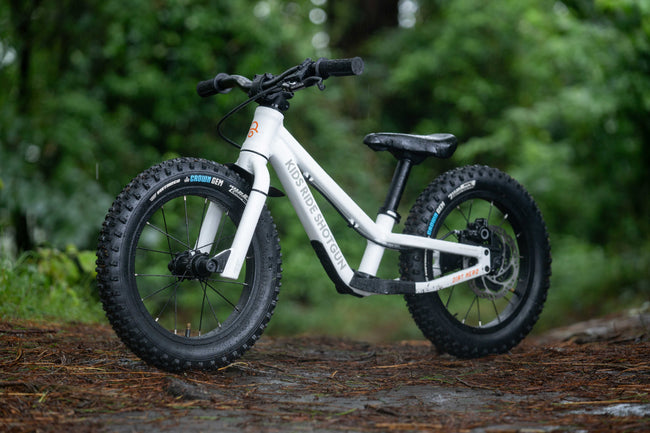
INTRODUCING THE DIRT HERO
For kids 2 - 5 years
12 - 14” convertible
2.25” Vee Tire Crown Gem pneumatic tires
Magura disc brake with child safe rotor guard
Trail ready mtb geometry & build quality
3 x mtb skins included
BUILD YOUR DREAM BIKE
GET OFF THE DRIVEWAY AND ONTO THE DIRT
Discover the must-have balance bike features for tackling off-road terrain.
| Suitable for riding off-road | Not suitable for riding off-road | Feature | Why? | Feature | Why? | Tires | Pneumatic knobbly MTB tires | - Increased grip off-road - Tires act as suspension |
Foam or slick tires | - Poor grip off-road - Hard tires give a bumpy ride |
Brakes | Hydraulic disc brake | - Increased stopping power for steeper terrain - Easy to pull levers |
V brakes | - Unreliable in the wet - Increased hand strength required to operate |
Frame shape | Slack and low MTB geometry | - Improved stability, handling, and weight distribution - Comfortable and confidence inspiring |
Traditional upright geometry | - Increased risk of Over-The-Handlebars (OTB) accidents when braking - Twitchy handling on descents |
Trail ready parts | Sealed cartridge bearings | - Protected from the elements - Longer lifespan |
Open race bearings | - Open to the elements - Shorter lifespan |
|---|---|---|---|---|

The Dirt Hero is the best off-road balance bike we have ever tested, sure to build confidence and skill level while providing endless hours of fun
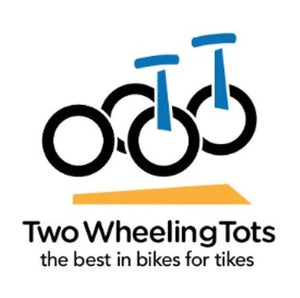

My daughter likes to ride in the dirt and blast down grass hills, and this bike feels a lot better. It’s shaped like an enduro bike, it’s long, it's low slung, it’s slack, it’s easier to hold a straight line on this bike. If you know your kid’s gonna be riding in the dirt and doing a lot of downhill, the enduro category actually delivers.


My daughter likes to ride in the dirt and blast down grass hills, and this bike feels a lot better. It’s shaped like an enduro bike, it’s long, it's low slung, it’s slack, it’s easier to hold a straight line on this bike. If you know your kid’s gonna be riding in the dirt and doing a lot of downhill, the enduro category actually delivers.
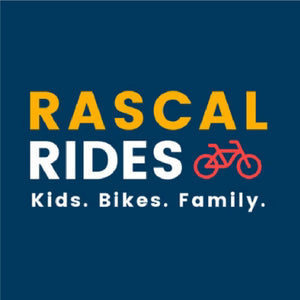

Kids Ride Shotgun may just have released the raddest balance bike around! We're talking chunky Vee Tire Co rubber, a Magura hydraulic disc brake and compatibility with dual wheel sizes, allowing an on-trend mullet set-up with super-slack head angle!

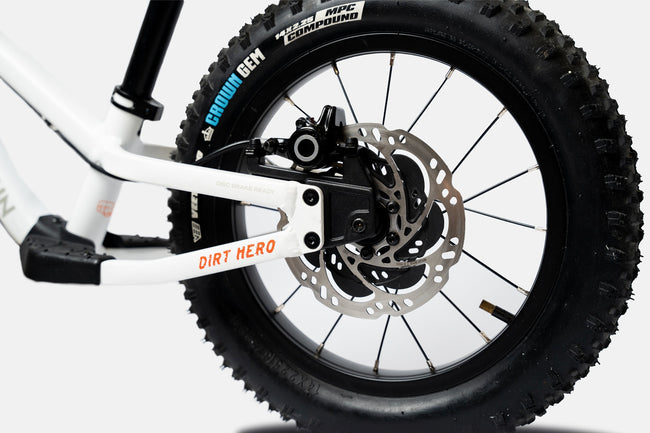
THE PERFECT BALANCE BIKE BRAKE
We’ve partnered with Magura to spec the ultimate brake for mini shredders.
Legendary performance, class-leading lever reach adjustment and the world’s first child safe rotor guard make this the perfect balance bike brake for MTB kids.
SHOP DIRT HERO®
EXPLORE BALANCE BIKE ACCESSORIES
-
DIRT HERO WHEEL KIT
5.0 / 5.0
(40) 40 total reviews
Sale price From$129.99Regular price $129.99Unit price / per -
UPSHIFT UNICORN WINDPROOF KIDS MTB JERSEY
5.0 / 5.0
(50) 50 total reviews
Sale price $49.99Regular price $49.99Unit price / per -
DIALLED DINO WINDPROOF KIDS MTB JERSEY
5.0 / 5.0
(50) 50 total reviews
Sale price $49.99Regular price $49.99Unit price / per -
LOOSE LION WINDPROOF KIDS MTB JERSEY
5.0 / 5.0
(50) 50 total reviews
Sale price $49.99Regular price $49.99Unit price / per
HELPFUL ARTICLES
How to choose the perfect off-road balance bike for your kid
Selecting the right balance bike for your little one involves making some big decisions – especially when it comes to the key components of the bike, as they have a profound impact on the overall experience your child will have. A positive early experience of mountain biking is more likely to inspire a lasting love for riding, underscoring the importance of making the right choice.
Below, we outline some important factors to consider when comparing balance bikes.
The Tires: Prioritize Grippy Pneumatic Tires
The choice of tires can significantly influence your child's off-road biking experience. Pneumatic tires provide exceptional traction and excel on various surfaces, including dirt trails, gravel paths, and muddy terrain. This traction is key for providing the grip and control your child needs to confidently and safely explore singletrack trails and off-road terrain.
Mountain bike (MTB) terrain is often unpredictable with bumps, roots or loose surfaces to navigate (which is all part of the fun!). Instead of being thrown around by these rough surfaces, air filled pneumatic tires act as suspension and effectively cushion the impact, offering a more comfortable and enjoyable ride for your child.
While there are more budget-friendly tire options available, such as solid plastic or foam tires, it's important to note that these alternatives are less versatile and provide inferior traction compared to pneumatic tires. Solid tires tend to lose grip on uneven surfaces and provide a bumpy ride, limiting your child's ability to comfortably tackle a variety of terrains – therefore we do not recommend them for off-road use.
The Frame: Focus On MTB Geometry
When riding off-road, the geometry of a balance bike becomes a critical factor. MTB specific geometry, such as a slack head angle (63 - 66 degrees), is designed to deliver the stability and control needed to conquer rough and uneven terrains. This confidence inspiring geometry is especially important for young riders who are still in the early stages of learning to balance and navigate off-road riding.
Choosing a frame with MTB geometry also ensures a smoother transition from a balance bike to a pedal bike when the time comes. By starting with this familiar geometry, your child will find it easier to adapt to a regular mountain bike when they get to one.
The Brakes: Ensure Easy Braking for Little Fingers
We are strong believers in teaching kids to brake before they learn to pedal, and it’s important to do this in a fun and safe manner. For the best possible experience, we always recommend opting for hydraulic disc brakes due to the numerous advantages they offer:
Disc brakes provide consistent and reliable stopping power and even perform well in the wet (unlike traditional V brakes), great for rainy rides. This reliability is important for preventing accidents and ensuring your child's safety, particularly when first learning to brake.
Hydraulic disc brakes also have the distinct advantage of requiring significantly less hand strength to operate – ideal for little hands. This allows for precise control over braking force which enables your child to modulate their speed with ease, boosting their confidence when navigating challenging and unfamiliar terrain.
Disc brake rotors can present a hazard if your child is playing with the wheels of the bike when not riding, therefore it’s important to choose a bike with additional safety features like rotor guards.
Teaching your child to ride off-road: 6 tips for shred success
Introducing your child to the joys of mountain biking is an exciting journey that can create lasting memories and instill valuable life skills. Hitting the trails on an off-road balance bike is the first step in mastering mountain biking and fostering a love for outdoor adventures. Whether you're just starting, or refining your approach, here are our top 6 tips for teaching your little one to tackle the trails.
1. Stack the Skills: Balance First, Then Brake (Before Introducing a Pedal Bike)
Teaching your child to ride a bike involves introducing skills in an engaging and digestible order. Begin indoors with a lightweight balance bike to lock in the first and most important skill, balancing. Next, transition to an off-road balance bike for outdoor practice, further enhancing their balance skills by tackling uneven terrain. The introduction of braking comes next and only after a solid grasp of balance has been achieved. This step-by-step approach prioritizes safety and fosters a robust foundation for bike control.
When first progressing to a pedal bike it can be helpful to keep your child’s balance bike available for riding more difficult trails - this keeps the stoke levels high whilst they get to grips with their new pedal bike. If you plan to overlap using both a pedal bike and an off-road balance bike, we recommend waiting until they have mastered braking to introduce the pedal bike.
By stacking the skills in this manner, you lay a dependable foundation for your child to enjoy each stage and progress at their own pace.
2. Start Small, Expand Gradually
Begin with simple, well-maintained trails like forest roads or the lowest level singletrack trails. These beginner-friendly environments build confidence and develop riding skills. As your child levels up, gradually introduce more challenging terrain at a comfortable pace for fun and engaging riding progression.
3. Pack Snacks and Hydration
Riding trails can be demanding, so make sure to bring plenty of drinks and food. Bring a backpack with snacks and a water bottle – include their favorite treat along with healthier options like granola bars and fruit slices for sustained energy.
4. Make It Fun and Rewarding
Having fun is rule number 1! As well as riding your little one's favorite trails, you can search out the biggest puddles to splash, play eye spy or set up a treasure hunt. Setting achievable riding goals like tackling a new trail or learning skids also adds excitement. High 5’s and high energy from mum or dad also keep the stoke levels at 10.
5. Prioritize Safety
Safety is paramount for your little one when mountain biking. Ensure proper protective gear, including a well-fitted safety standards certified helmet, knee and elbow pads and gloves. Regularly inspect the balance bike, checking tires and brakes – which is also a great opportunity to get your little one involved in some basic bike maintenance and foster a sense of ownership for their bike.
6. Be Patient and Supportive
Every child learns at their own pace and it’s important to be patient and supportive throughout their journey. Celebrate their achievements, no matter how small, and provide encouragement and reassurance when the going gets tough.
Safety first: Off-road riding tips for balance bike kids
Introducing your child to the thrill of mountain biking is an exciting moment, but safety should always be a top priority. To ensure a safe and enjoyable experience, it's crucial to follow some key safety guidelines.
Here are our top tips to keep your little one safe on the trails:
1. Proper Protective Gear:
Mountain biking is a challenging and rewarding activity, however we’re all aware that falling (and getting back up) is all part of the journey. It’s important to mitigate the risk of riding with proper protective gear, which will also see your little one brushing off the dirt and jumping back on their bike with a smile. Here are three 3 key elements of protective gear for little riders:
A. A Well-Fitted, Standards Approved, Helmet:
A well-fitted helmet is the single most important piece of safety equipment for your child. It provides crucial head protection in case of falls or collisions. Ensure the helmet fits snugly but comfortably on your child's head, with the straps securely fastened. Helmets designed specifically for biking offer superior protection. We wrote a whole article about choosing your child's helmet - read it here.
B. Knee and Elbow Pads:
Knee and elbow pads are great for guarding against abrasions, cuts, and bruises during off-road biking adventures. These protective pads cushion impacts and reduce the risk of injury in case of falls. Like helmets, ensure knee and elbow pads fit properly and stay securely in place.
C. Gloves:
Gloves serve a dual purpose—they protect your child's hands from scratches and blisters while also providing a better grip on the handlebars. Choose gloves designed for biking with padding on the palms for added comfort and protection.
2. The Right Bike:
Not all bikes are suitable for riding off-road – make sure to check your kids bike has these key features if you’re planning on hitting the trails.
A. Brakes:
When selecting an off-road balance bike, prioritize models equipped with brakes. Brakes are vital for teaching your child essential stopping and slowing-down skills. They provide a level of control that enhances safety on off-road terrains. Disc brakes, in particular, offer reliable stopping power even in challenging conditions ( more on this in our top article)
B. Pneumatic Tires:
Opt for a balance bike with pneumatic (air-filled) tires. Pneumatic tires provide superior traction and shock absorption, making off-road biking safer and more comfortable. They perform exceptionally well on various surfaces, from dirt trails to gravel paths and rocky terrain. The added grip and control they offer are invaluable for your child's confidence and safety.
3. Proper Maintenance:
Maintaining your kids' balance bike is important for a safe and enjoyable ride together.
A. Regularly Inspect the Bike:
Before each ride, inspect the balance bike for any signs of wear or damage. Check the tires for proper inflation and look for loose fastenings. Ensure to check the brakes are functioning correctly before setting off.
B. Maintain Tire Pressure:
Maintaining the correct tire pressure is crucial for safe off-road biking. Flat tires can affect the bike's handling or damage the wheels, while over-inflated tires may result in a harsh ride. Refer to the manufacturer's recommendations for the appropriate tire pressure and use a gauge to ensure accuracy, noting that riding off-road requires a lower psi than riding on paved surfaces.
4. Supervision and Education:
Hitting the trails with your balance bike kid is an amazing bonding experience and a great opportunity to help them learn and grow. It’s also important to remember that they’re still learning to ride and should never be left to ride on their own.
A. Supervise Your Child:
Always supervise your child when mountain biking together. Keep an eye on their progress and provide guidance when needed. Encourage safe riding practices, such as proper braking techniques and staying on designated trails.
bB Educate Your Child:
Being out riding together is a great opportunity to teach your child about the importance of safety whilst riding. Explain the significance of wearing protective gear, ensure you’re also wearing a helmet to model this behavior, and demonstrate how to use the brakes effectively. Encourage them to ask questions and express any concerns they may have.
EXPLORE MORE OVER ON INSTAGRAM
THE LATEST FROM OUR BLOG
-
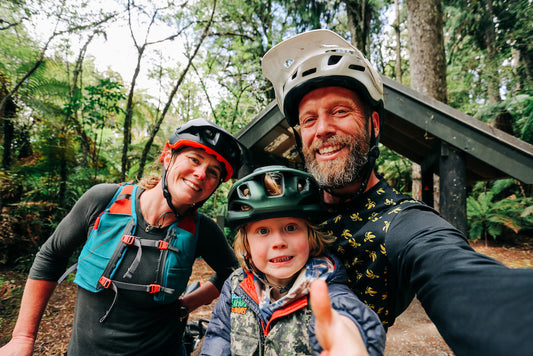
No phone signal, no screens, no problem
Dan Necklen"Riding and camping under the canopy, it was beautiful to share the experience as a family, winding through one of the world's last prehistoric rainforests, rich in wildlife and trees...
No phone signal, no screens, no problem
Dan Necklen"Riding and camping under the canopy, it was beautiful to share the experience as a family, winding through one of the world's last prehistoric rainforests, rich in wildlife and trees...
-
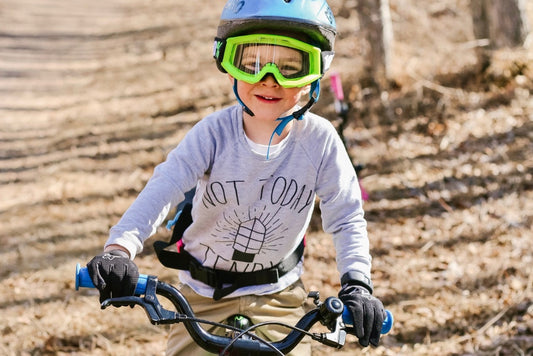
Best kids MTB gloves for toddlers 2-5 years
Dan NecklenIf you’re raising a mountain bike kid that’s under 5 years of age, it can be tough to find gloves that are small enough to fit their little hands. With...
2 commentsBest kids MTB gloves for toddlers 2-5 years
Dan NecklenIf you’re raising a mountain bike kid that’s under 5 years of age, it can be tough to find gloves that are small enough to fit their little hands. With...
2 comments -
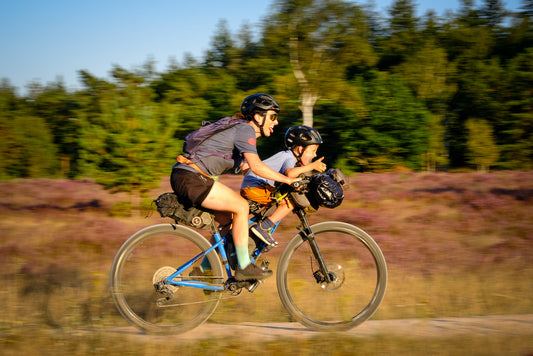
Biking 300km with two toddlers on-board. A five...
Stephanie NielsenWith one week of holiday left and an excellent weather forecast, we decided to go for a trip that was close to home. The Green Divide, created by Erwin Sikkens,...
1 commentBiking 300km with two toddlers on-board. A five...
Stephanie NielsenWith one week of holiday left and an excellent weather forecast, we decided to go for a trip that was close to home. The Green Divide, created by Erwin Sikkens,...
1 comment

